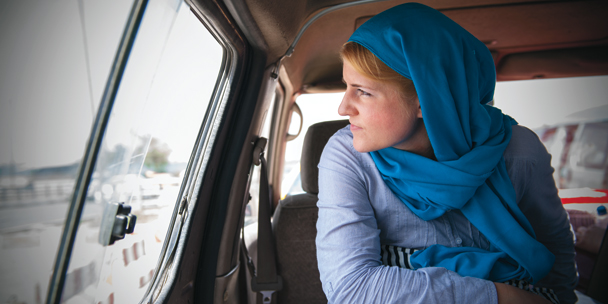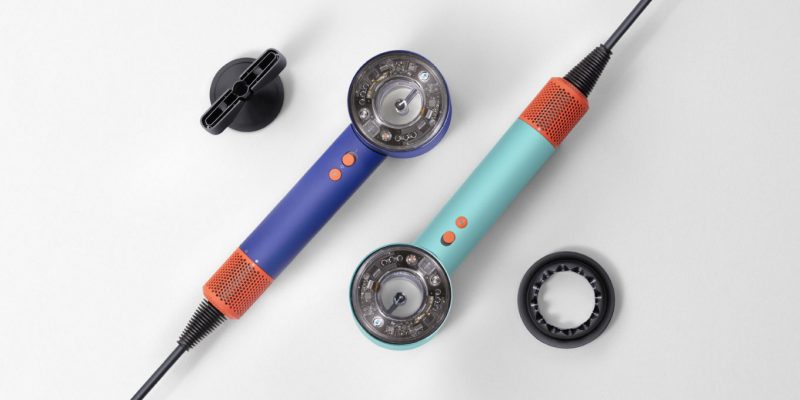Travel
ELLE World: Writing a new future for Afghanistan
Canadian Lauryn Oates believes in the women of Afghanistan.
by : Roberta Staley- Apr 19th, 2013

Lauryn Oates, projects director for Canadian Women for Women in Afghanistan, on one of her 36 trips to the country to set up and manage educational and life-skills programs. Photography by Tallulah Photography.
Lauryn Oates reaches over to close the curtains tightly on her side of our nondescript brown van. “Are the doors locked? Please close those curtains,” she firmly requests as we approach downtown Charikar, Afghanistan. We are 90 minutes north of the capital city of Kabul, en route to a school in the province of Panjshir in northeastern Afghanistan. Although I want to check out the carts piled high with eggplants, the sheaves of cilantro and the displays of traditional Afghan scarves, it’s too dangerous to do so. We can’t risk being seen by the criminal gangs that prowl Charikar. “They would sell us to the Taliban,” Oates says in her calm, sang-froid manner. As Canadian women— foreigners—our lives could easily become currency in the Islamic extremist group’s protracted campaign of terrorism and propaganda against the national government and those it considers puppets of the West.
Despite the safety risks, this is Oates’ 36th trip to Afghanistan in the past decade. The 31-year-old Burnaby, B.C., resident is projects director for Canadian Women for Women in Afghanistan (CW4WAfghan), an NGO founded in Calgary and Toronto in 1996 after the Taliban seized power in Afghanistan. CW4WAfghan, which is mainly run by 800 volunteer Canadian members, has 13 chapters across Canada and raises about $400,000 annually to fund and set up education, literacy and life-skills projects in Afghanistan. The group has an office in Kabul and a small staff of Afghan nationals who implement and monitor the projects when Oates is in Canada.
More ELLE World: A journey to save lives in SOUTH SUDAN
Oates first became aware of the plight of Afghan women when she was a teenager. “I read a newspaper article when I was 14,” she says. “It was 1996, and the Taliban had just captured Kabul. I read about how they had executed people by bulldozing a rock wall on top of them. Women in burkas were being beaten by Taliban police if skin showed or if the click of heels was heard. Cosmetics were banned, and women were stoned, beaten, jailed or shot for breaking these rules. They couldn’t attend school or work. The people were existing like ghosts. After I read the article, I felt physically ill for a couple of days—it brought on a surge of anger that never really went away. The only way that I could feel better was by doing something.”
Two years later, she created the Vancouver chapter of CW4WAfghan (she is considered a co-founder) and continued to volunteer with the organization for the next decade. Then, five years ago, while working on her Ph.D. in language and literacy education at the University of British Columbia, she landed her current gig as projects director.
SLIDESHOW ELLE World: SOUTH SUDAN in photos
 The number of Afghan girls attending school is now at 79 percent–up from 4 percent during the five years of Taliban rule. Photography by Tallulah Photography.
The number of Afghan girls attending school is now at 79 percent–up from 4 percent during the five years of Taliban rule. Photography by Tallulah Photography.
CW4WAfghan is part of an international effort by NATO countries and NGOs to transform girls’ and women’s lives and rebuild civil society in Afghanistan, which has been mired in civil war for more than three decades. The United Nations Educational, Scientific and Cultural Organization (UNESCO) puts the number of girls now in school at 79 percent—up from 4 percent during the five years of Taliban rule.
I have joined Oates to see how she carries out CW4WAfghan’s work. Thanks to this non-profit group, 50,000 girls are now attending school each year who would not have previously. The NGO also provides teachers with intensive training in subjects like math, chemistry, biology, Dari literature and English. To date, 4,000 teachers have graduated from the CW4WAfghan training courses. “Countries most likely to be at war are those with the worst education systems,” Oates tells me passionately. “The status of women is the single greatest predictor of instability—and in Afghanistan, the mother’s education level determines the level of income, child mortality, sanitation and close to 80 other indicators. Education is a life-and-death issue,” she says, citing data from the 2010–2011 Afghanistan Multiple Indicator Cluster Survey, a joint UNICEF-Afghan government report.
More ELLE World: Story of a designer from SOUTH SUDAN
Our van has made it safely through Charikar, and we’re free once again to open the curtains to peer out at a beautiful landscape of sharp mountains and the frothing jadegreen waters of the Panjshir River. It was along a road similar to this that Oates lost her good friend and fellow educator Jackie Kirk (of Montreal) to Taliban insurgents in 2008. Kirk and three others were killed when a group of Taliban gunmen fired on their International Rescue Committee van with Kalashnikovs. The act of terrorism was a turning point for Oates. “I’ve had my own close calls, but when I saw footage of her body and the coffin, it was really, really real. I was in Canada at the time, and I wasn’t looking forward to going back. I was scared and depressed.” But Oates weighed the alternatives. “It was either avoid the risk and disengage or accept that the work is more important than the risk. I never questioned it again. I made my peace.”
 Afghan girls congregate outside the classroom. Photography by Tallulah Photography.
Afghan girls congregate outside the classroom. Photography by Tallulah Photography.
Several hours later, we pull up to our destination: a 13-year-old dun-brick state-built school in Panjshir. As part of her work, Oates monitors the instructors who have been through CW4WAfghan’s teacher-training program. Before we disembark, Oates tucks stray locks of blond hair under her blue head scarf. I follow suit, ensuring that my unruly curls are hidden under a brown scarf so that I, too, uphold Afghanistan’s strict standards of modesty.
As curious faces peer out from the school’s windows, Oates gives me a quick cultural briefing. If we meet male administrators and teachers, “don’t try to shake their hands, and they may not look you in the eye,” she says. Rural Panjshir is conservative—a place where mullahs, or Islamic leaders, enforce a moral code steeped in misogyny. Oates recounts one mullah’s edict: “‘First, there is God,’ he said, ‘then men, then children, then ghosts, then women.’” She rolls her eyes.
More ELLE World: One woman’s fight to END CHILD EXECUTIONS
Oates’ visits, which can take from a few hours to half a day, must be kept secret ahead of time to prevent the local Taliban from finding out. As such, the principal and teachers are surprised to see us, but they greet Oates as a friend, and she responds with a big, warm smile and an easy laugh. The coolness of the dim hallways is welcome relief from the oppressive summer heat. We enter a chemistry class, where 17 teenage girls of varying ages are seated at worn and nicked wooden desks. The teacher, 21-year-old Zahra Roshanfekr, is demonstrating chemical reactions by combining calcium carbide with water to produce acetylene gas. Three students assist with the experiment. Roshanfekr, who has large almond-shaped eyes and is dressed in a dark hijab and flowing tunic, took CW4WAfghan’s teacher training to complement her training at the state teachers college. CW4WAfghan trains teachers to use active learning and hands-on instruction in class instead of rote learning, lecturing and memorization, which still prevails in Afghanistan. Roshanfekr says that prior to taking the 30 days of intensive chemistry training, she’d been afraid to handle chemicals. “I had no experience doing experiments,” she tells us through a translator. “Now I’m more confident using these materials.” And she’s thrilled at how the students respond to the hands-on learning. “When we do experiments, I see how the students ‘get it,’” she says with a smile.
 Teacher Zahra Roshanefekr (in teal) leading a chemistry lesson at a school in Panjshir province. Photography by Tallulah Photography.
Teacher Zahra Roshanefekr (in teal) leading a chemistry lesson at a school in Panjshir province. Photography by Tallulah Photography.
After class, Oates and I speak to 17-year-old Rowid Danishjo. She’s the first of her seven sisters to attend any school, “because of the Taliban,” she says. Danishjo tells us that she intends to forgo marriage and attend university but feels unprepared for the upcoming national exams that will determine university entrance. Last month, “there was no math or chemistry teacher,” she says. And there is no Internet to fill the gap left by a teacher shortage. Despite the challenges, Danishjo has hopes for Afghanistan’s future: “I wish for peace, security, work and stability.”
The classroom, says Oates, is the best place to change attitudes that result in gender inequalities. “One of the teachers told me about how he gave male students a lesson in brain anatomy using a CW4WAfghan-donated science kit,” she says. “When the instructor finished, the boys asked to see the brain of a woman. When the teacher told them that the brains of men and women are the same, the boys were astounded.” One of the more radical measures that CW4WAfghan has undertaken in some schools is placing boys and girls together in the same classroom—going against the tradition of purdah, which dictates that females must be segregated from males. “By doing this, young women learn that they stand shoulder to shoulder with males, academically and socially,” says Oates.
More ELLE World: The INDIAN ORGAN TRAIL
Out of fear for the safety of their aid workers, many NGOs are already preparing to leave the country at the end of 2014 (when foreign troops are set to withdraw). But Oates is determined to continue the work of CW4WAfghan and stand by the Afghan people, who have embraced change and hope for a secure future.
“Sixty-five percent of the population is under the age of 24,” says Oates. “They don’t want to grow up to be warlords; they want to be doctors, engineers and teachers. When you see people become literate, their lives are changed instantly. The women of Afghanistan who have gone from illiterate to being able to read say ‘Before, I was blind; now I see.’”
Canadian Women for Women in Afghanistan’s Lantern Fund is aiming to raise $2 million in the next five years to train 5,000 teachers in Afghanistan. Visit CW4WAfghan.ca for more information.
 Afghan youth, like filmmaker Anita Haidary, are not staying silent; she speaks out with her documentary My Voice, My Story. Photography by Tallulah Photography.
Afghan youth, like filmmaker Anita Haidary, are not staying silent; she speaks out with her documentary My Voice, My Story. Photography by Tallulah Photography.
Local efforts
It’s not just the international community effecting change in Afghanistan. One of the country’s most revolutionary grassroots organizations is Young Women for Change (YWC), which organized Kabul’s first-ever protest march in 2011 opposing the persistent grabbing, groping and lewd insulting of females by men. I spent an evening in the YWC office in Kabul, where more than 20 young university-educated women and men had gathered to preview Anita Haidary’s new documentary, My Voice, My Story, to be broadcast on Kabul television. Haidary, 20, is co-founder of YWC and filmed her documentary as a platform for young women to express their humiliation and rage over some men’s execrable behaviour. “Men harass women and girls to show their power, to show that they own the streets, to show us that they don’t consider us human,” she says. “That has to stop.” Championing the motto “Being silent is NOT an answer,” YWC runs awareness programs to spur women into participating in political and social life, does spontaneous advocacy for victims of violence on social-media platforms and organizes marches. “They are absolute feminists and incredibly courageous,” says CW4WAfghan’s Lauryn Oates. “They are really getting some men to change.”
More ELLE World: Investigating the road to CHOCOLATE

The Toofan beauty salon in Kabul, Afghanistan. Photography by Tallulah Photography.
A beautiful sanctuary: The Toofan beauty salon is transforming more than appearances.
In Kabul’s Toofan beauty salon, about 20 women with tightly pinned curls sit on chairs and gossip while toddlers whiz about underfoot. Another half-dozen women in curlers are being primped in front of the salon’s long mirror. One of them is 21-year-old Zakiah Hakim, who is visiting from London, England. “The point is to look like a movie star,” she says, fluttering false eyelashes, as she is prepped for her sister’s wedding. Toofan, as well as Kabul’s many other popular salons, are places of subtle change and quiet public discourse. Even during the five years of Taliban rule, Toofan was an oasis for women. From 1996 to 2001, the business operated out of a private home as a “tailoring shop,” says co-owner Fariba Ejtemai. Cosmetics were forbidden under the Taliban, but that didn’t stop some women from getting dolled up for special occasions where men and women are separated. That salons like Toofan now operate in the open is a sign of progress in Afghanistan. “Salons are a way for women to achieve economic independence,” says Ejtemai. “We can support our families and put our children through school.”
Newsletter
Join our mailing list for the latest and biggest in fashion trends, beauty, culture and celebrity.
Read Next

Beauty
Dyson Just Launched Its Most Intelligent Hair Dryer Yet
Get ready to upgrade your blowout game.
by : Lauren Knowles- Apr 25th, 2024

Fashion
Meredith Shaw Created a Plus-Size Summer Dress Collection That "Feels Like Candy"
The morning show host joined forces with PENN. to create a curated collection for sizes 14-32.
by : Allie Turner- Apr 25th, 2024

Beauty
Summer Prep: How to Feel Confident in Your Swimsuit
New Size-Inclusive Swimwear: Gillette Venus partners with The Saltwater Collective to Launch a Collection for Any Body
by : ELLE Canada- Apr 24th, 2024




